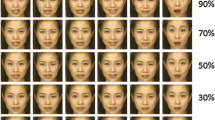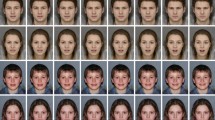Abstract
We examined upper facial basic emotion recognition in 57 subjects with autism spectrum disorders (ASD) (M = 13.5 years) and 33 typically developing controls (M = 14.3 years) by using a standardized computer-aided measure (The Frankfurt Test and Training of Facial Affect Recognition, FEFA). The ASD group scored lower than controls on the total scores of FEFA and perceived ambiguous stimuli more often as a negative emotion. The older ASD group (≥12 years) performed better than the younger ASD group (<12 years) on the blended emotions of FEFA. The results support the findings that individuals with ASD have difficulties in emotion recognition. However, older subjects with ASD seem to have better skills than younger subjects with ASD.




Similar content being viewed by others
References
Albertowski, K., Bölte, S., & Poustka, F. (2007). Basic affect identification in autism and other child and adolescent mental disorders (article in German). 1. Wissenschaftliche Tagung Autismus-Spektrum-Störungen. Abstractband (p. 35). Berlin, Frankfurt/M:MPIB.
Ashwin, C., Baron-Cohen, S., Wheelwright, S., O’Riordan, M., & Bullmore, E. T. (2007). Differential activation of the amygdale and the ‘social brain’ during fearful face-processing in Asperger syndrome. Neuropsychologia, 45, 2–14. doi:10.1016/j.neuropsychologia.2006.04.014.
Attwood, A., Frith, U., & Hermelin, B. (1988). The understanding and use of interpersonal gestures by autistic and Down’s syndrome children. Journal of Autism and Developmental Disorders, 18, 241–257. doi:10.1007/BF02211950.
Back, E., Mitchell, P., & Ropar, D. (2007). Do the eyes have it? Inferring mental states from animated faces in autism. Child Development, 78(2), 397–411. doi:10.1111/j.1467-8624.2007.01005.x.
Baron-Cohen, S., Leslie, A. M., & Frith, U. (1985). Does the autistic child have a theory of mind? Cognition, 2, 37–46. doi:10.1016/0010-0277(85)90022-8.
Beck, A. T. (1976). Cognitive therapy and the emotional disorders. New York: International Universities Press.
Bölte, S., Feineis-Matthews, S., & Poustka, F. (2003). Frankfurter test und training des erkennens von fazialem affekt, FEFA. Frankfurt am Main: J.W. Goethe-Universitätsklinikum.
Bölte, S., Feineis-Matthews, S., & Poustka, F. (2008). Brief report: Emotional processing in high-functioning autism-physiological reactivity and affective report. Journal of Autism and Developmental Disorders, 38(4), 776–781. doi:10.1007/s10803-007-0443-8.
Bölte, S., Hubl, D., Feineis-Matthews, S., Prvulovic, D., Dierks, T., & Poustka, F. (2006). Facial affect recognition training in autism: can we animate the fusiform gyrus? Behavioral Neuroscience, 120, 211–216. doi:10.1037/0735-7044.120.1.211.
Bölte, S., & Poustka, F. (2003). The recognition of facial affect in autistic and schizophrenic subjects and their first-degree relatives. Psychological Medicine, 33, 907–915. doi:10.1017/S0033291703007438.
Boraston, Z., Blakemore, S.-J., Chilvers, R., & Skuse, D. (2007). Impaired sadness recognition is linked to social interaction deficit in autism. Neuropsychologia, 45, 1501–1510. doi:10.1016/j.neuropsychologia.2006.11.010.
Buitelaar, J. K., van der Wees, M., Swaab-Barneveld, H., & van der Gaag, R. J. (1999). Theory of mind and emotion-recognition functioning in autistic spectrum disorders and in psychiatric control and normal children. Development and Psychopathology, 11, 39–58. doi:10.1017/S0954579499001947.
Castelli, F. (2005). Understanding emotions from standardized facial expressions in autism and normal development. Autism, 9, 428–449. doi:10.1177/1362361305056082.
Custrini, R. J., & Feldman, R. S. (1989). Children’s social competence and nonverbal encoding and decoding of emotions. Journal of Clinical Child Psychology, 18, 336–342. doi:10.1207/s15374424jccp1804_7.
Dawson, G., Toth, K., Abbott, R., Osterling, J., Munson, J., Estes, A., et al. (2004a). Early social attention impairments in autism: Social orienting, joint attention and attention to distress. Developmental Psychology, 40, 271–283. doi:10.1037/0012-1649.40.2.271.
Dawson, G., Webb, S. J., Carver, L., Panagiotides, H., & McPartland, J. (2004b). Young children with autism show atypical brain responses to fearful versus neutral facial expressions of emotion. Developmental Science, 7, 340–359. doi:10.1111/j.1467-7687.2004.00352.x.
Ehlers, S., Gillberg, C., & Wing, L. (1999). A screening questionnaire for Asperger syndrome and other high-functioning autism spectrum disorders in school age children. Journal of Autism and Developmental Disorders, 29, 129–141. doi:10.1023/A:1023040610384.
Ekman, P., & Friesen, W. V. (1976). Pictures of facial affect. Palo Alto, CA: Consulting Psychologist Press.
Eysenk, M. W. (1992). Anxiety: The cognitive perspective. Hove: Erlbaum.
Golan, O., & Baron-Cohen, S. (2006). Systemizing empathy: Teaching adults with Asperger syndrome or high-functioning autism to recognize complex emotions using interactive multimedia. Development and Psychopathology, 18, 591–617. doi:10.1017/S0954579406060305.
Gross, T. F. (2004). The perception of four basic emotions in human and nonhuman faces by children with autism and other developmental disabilities. Journal of Abnormal Child Psychology, 32, 469–480. doi:10.1023/B:JACP.0000037777.17698.01.
Grossman, J. B., Klin, A., Carter, A. S., & Volkmar, F. R. (2002). Verbal bias in recognition of facial emotions in children with Asperger syndrome. Journal of Child Psychology and Psychiatry, and Allied Disciplines, 41, 369–379. doi:10.1111/1469-7610.00621.
Howlin, P., & Asgharian, A. (1999). The diagnosis of autism and Asperger syndrome: Findings from a survey of 770 families. Developmental Medicine and Child Neurology, 41, 834–839. doi:10.1017/S0012162299001656.
Kaland, N., Smith, L., & Mortensen, E. L. (2007). Response times of children and adolescents with Asperger syndrome on an ‘advanced’ test of theory of mind. Journal of Autism and Developmental Disorders, 37, 197–209. doi:10.1007/s10803-006-0152-8.
Klin, A., Jones, W., Schultz, R., Volkmar, F., & Cohen, D. (2002). Visual fixation patterns during viewing of naturalistic social situations as predictors social competence in individuals with autism. Archives of General Psychiatry, 59, 809–816. doi:10.1001/archpsyc.59.9.809.
Klucharev, V., & Sams, M. (2004). Interaction of gaze direction and facial expressions processing: ERP study. Neuroreport, 15(4), 621–626. doi:10.1097/00001756-200403220-00010.
Kohler, C. G., Turner, T., Stolar, N. M., Bilker, W. B., Brensinger, C. M., Gur, R. E., et al. (2004). Differences in facial expressions of four universal emotions. Psychiatry Research, 128, 235–244. doi:10.1016/j.psychres.2004.07.003.
Korpilahti, P., Jansson-Verkasalo, E., Mattila, M.-L., Kuusikko, S., Suominen, K., Rytky, S., et al. (2007). Processing of affective speech prosody is impaired in Asperger syndrome. Journal of Autism and Developmental Disorders, 37, 1539–1549. doi:10.1007/s10803-006-0271-2.
Kujala, T., Lepistö, T., Nieminen-von Wendt, T., Näätänen, P., & Näätänen, R. (2005). Neurophysiological evidence for cortical discrimination impairment of prosody in Asperger syndrome. Neuroscience Letters, 383, 260–266. doi:10.1016/j.neulet.2005.04.048.
Kuusikko, S., Pollock-Wurman, R., Ebeling, H., Hurtig, T., Joskitt, L., Mattila, M.-L., Jussila, K., & Moilanen, I. (2008a). Psychometric evaluation of social phobia and anxiety inventory for children (SPAI-C) and social anxiety scale for children-revised (SASC-R). [Epub ahead of print].
Kuusikko, S. Pollock-Wurman, R., Jussila, K., Carter, A. S., Mattila, M.-L., Ebeling, H., Pauls, D. L., & Moilanen, I. (2008b). Social anxiety in high-functioning children and adolescent with autism spectrum disorders. Journal of Autism and Developmental Disorders, [Epub ahead of print].
Laihaie, A., Mottron, L., Arguin, M., Berthiaume, C., Jemel, B., & Saumier, D. (2006). Face perception in high-functioning autistic adults: Evidence for superior processing of face parts, not for configural face-processing deficit. Neuropsychology, 20, 30–41. doi:10.1037/0894-4105.20.1.30.
Lindner, J., & Rosén, L. (2006). Decoding of emotion through facial expression, prosody and verbal content in children and adolesscents with Asperger’s syndrome. Journal of Autism and Developmental Disorders, 36, 769–777. doi:10.1007/s10803-006-0105-2.
Lord, C., Rutter, M., DiLavore, P. C., & Risi, S. (2000). Autism diagnostic observation schedule (ADOS). Los Angeles: Western Psychological Services.
Lord, C., Rutter, M., & LeCouteur, A. (1995). Autism diagnostic interview—revised (3rd ed.). Los Angeles: Western psychological services.
Macdonald, H., Rutter, M., Howlin, P., Rios, P., LeCouter, A., Evered, C., et al. (1989). Recognition and expression of emotional cues by autistic and normal adults. Journal of Child Psychology and Psychiatry, and Allied Disciplines, 30, 865–878. doi:10.1111/j.1469-7610.1989.tb00288.x.
Mattila, M.-L., Kielinen, M., Jussila, K., Linna, S. L., Bloigu, R., Ebeling, H., et al. (2007). An epidemiological and diagnostic study of Asperger syndrome according to four sets of diagnostic criteria. Journal of the American Academy of Child and Adolescent Psychiatry, 46, 636–646. doi:10.1097/chi.0b013e318033ff42.
Melfsen, S., Walitza, S., & Warnke, A. (2006). The extent of social anxiety in combination with mental disorders. European Child & Adolescent Psychiatry, 15, 111–117. doi:10.1007/s00787-006-0510-2.
Meltzoff, A. N., & Moore, M. K. (1977). Imitation of facial and manual gestures in human neonates. Science, 198, 75–78. doi:10.1126/science.198.4312.75.
Montagne, B., Kessels, R. P., De Haan, E. H., & Perret, D. I. (2007). The emotion recognition task: A paradigm to measure the perception of facial emotional expressions at different intensities. Perceptual and Motor Skills, 104, 589–598. doi:10.2466/PMS.104.2.589-598.
Pelphrey, K. A., Sasson, N. J., Reznick, J. S., Paul, G., Goldman, B. D., & Piven, J. (2002). Visual scanning of faces in autism. Journal of Autism and Developmental Disorders, 32, 249–261. doi:10.1023/A:1016374617369.
Rutherford, M. D., & McIntosh, D. N. (2007). Rules versus prototype matching: Strategies of perception of emotional facial expressions in the autism spectrum. Journal of Autism and Developmental Disorders, 37, 187–196. doi:10.1007/s10803-006-0151-9.
Sigman, M. D., Kasari, C., Kwon, J. H., & Yirmiya, N. (1992). Responses to the negative emotions of others by autistic, mentally retarded and normal children. Child Development, 63, 796–807. doi:10.2307/1131234.
Silver, M., & Oakes, P. (2001). Evaluation of a new computer intervention to teach people with autism or Asperger syndrome to recognize and predict emotions in others. Autism, 5, 299–316. doi:10.1177/1362361301005003007.
Smith, L. S., Dmochowski, P. A., Muir, D. W., & Kisilevsky, B. S. (2007). Estimated cardiac vagal tone predicts fetal responses to mother’s and stranger’s voices. Developmental Psychobiology, 49, 543–547. doi:10.1002/dev.20229.
Tonks, J., Williams, W. H., Frampton, I., Yates, P., & Slater, A. (2007). Assessing emotion recognition in 9–15-years olds: Preliminary analysis of abilities in reading emotion from faces, voices and eyes. Brain Injury: [BI], 21, 623–629. doi:10.1080/02699050701426865.
van der Geest, J. N., Kemner, C., Verbaten, M. N., & Engeland, H. (2002). Gaze behaviour of children with pervasive developmental disorder toward human faces: A fixation time study. Journal of Child Psychology and Psychiatry, and Allied Disciplines, 43, 669–778. doi:10.1111/1469-7610.00055.
Wechsler, D. (1991). Wechsler intelligence scale for children, third edition (WISC-III). New York: The Psychological Corporation.
Woodhead, M., Barnes, P., Miell, D., & Oates, J. (1995). Developmental perspectives on emotion. In P. Barnes (Ed.), Personal, social, and emotional development of children (pp. 136–176). UK: Alden Press.
World Health Organization (WHO). (1993). Tenth revision of the international classification of disease. Geneva: World Health Organization.
Acknowledgments
The research was supported by The Alma and K. A. Snellman Foundation, Oulu, Finland (PI: S. Kuusikko, H. Haapsamo, M-L. Mattila); Child Psychiatric Research Foundation, Finland (PI: S. Kuusikko, M-L. Mattila); Child Psychiatric Research Foundation, Northern Ostrobothnia Hospital District Area, Finland (PI: S. Kuusikko, M-L. Mattila); Emil Aaltonen Foundation, Finland (PI: H. Ebeling); the Rinnekoti Research Foundation, Espoo, Finland (PI: M-L. Mattila); Thule Institute, University of Oulu (PI: I. Moilanen); and Juselius Foundation (PI: I. Moilanen). The Graduate School of Circumpolar Wellbeing, Health and Adaptation is acknowledged for their support. We want to thank the participants of the study, Clinical Psychologist Raija Ollikainen for translating the FEFA in Finnish, Ms Kaisa Kouri, Ms Katja Larinen, and Mr Jukka Rahko for their help in data collection, and Leena Joskitt for her statistical advises.
Author information
Authors and Affiliations
Corresponding author
Rights and permissions
About this article
Cite this article
Kuusikko, S., Haapsamo, H., Jansson-Verkasalo, E. et al. Emotion Recognition in Children and Adolescents with Autism Spectrum Disorders. J Autism Dev Disord 39, 938–945 (2009). https://doi.org/10.1007/s10803-009-0700-0
Received:
Accepted:
Published:
Issue Date:
DOI: https://doi.org/10.1007/s10803-009-0700-0




